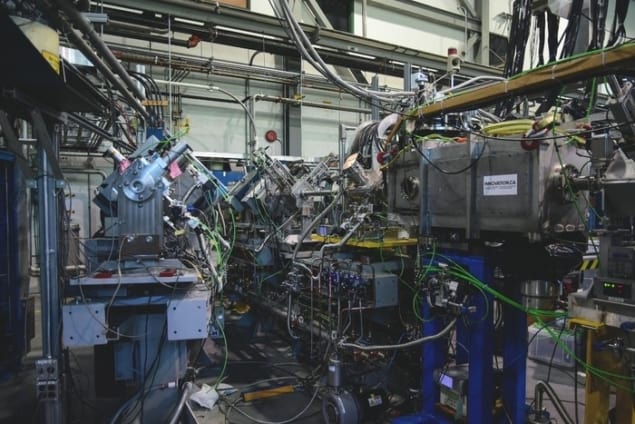
An unexpected deformation has been discovered in the helium-8 nucleus by an international team led by Matthias Holl and Rituparna Kanungo, both at Saint Mary’s University in Canada. The researchers used cutting-edge instruments at the TRIUMF facility in Vancouver to reveal a rugby-ball shape for the neutron-rich nucleus. Theoretical calculations based on the no-core shell model also suggest a deformed shape and the research provides important information about how nucleons (protons and neutrons) interact within atomic nuclei.
The nuclear shell model describes the structure of nuclei in terms of shells of energy levels that are occupied by nucleons. If a nuclear shell is closed, it contains the maximum number of allowed protons or neutrons in that shell. If any further nucleons are added to the nucleus, they are valence nucleons and exist in an unfilled shell surrounding the closed inner shell. The shell model is a work in progress and physicists are improving it by studying the properties of a range of nuclei.
Neutron skin
Within a helium-4 nucleus, both protons and neutrons exist in closed shells of two nucleons each – resulting in a highly stable nucleus. Helium-8 has four extra neutrons that form a “skin” around a helium-4 core. Physicists believe that these neutrons could form a closed sub-shell. This would make helium-8 a doubly-closed-shell nucleus.
So far, the few doubly-closed-shell nuclei studied by physicists are spherical. In their study, Holl and Kanungo’s team investigated whether this holds true for helium-8 by doing proton inelastic scattering experiments at TRIUMF’s 520 MeV cyclotron. They fired an beam of doubly ionized helium-8 nuclei at solid hydrogen target that was cooled to 4 K. Using the IRIS spectroscopy station, which is headed by Kanungo, they analysed the scattered nuclei.

New superheavy isotope and excited state could point the way to islands of stability
Their results revealed a large energy gap between the ground and first excited states of the helium-8 nucleus. This supports previous predictions that the nucleus contains a closed sub-shell of neutrons. Yet contrary to past predictions, the analysis also revealed that this shell is not spherical. Instead, it has a prolate spheroidal – or rugby ball – shape, being elongated along its central axis.
In parallel with these experiments, teams across several different institutions made their own theoretical predictions of the shape of helium-8 from first principles. When their calculations were based on a no-core shell model, where the nucleus’ inner protons and neutrons are allowed to interact with its outer neutron sub-shell, the results closely matched the TRIUMF measurements.
Holl and Kanungo’s team hope that their work will inspire future investigation into the deformation of helium-8, potentially unveiling new types of nuclear interaction.
The research is described in Physics Letters B.



